How it all came to be
How it all came to be
It all started very optimistically.
On the 11th of March, we, the graduating students of Graphic Design, faculty of the British Higher School of Art and Design, first gathered all together in our studio to collectively decide upon our Final Degree Show. By that time, there were only 8 cases of Covid-19 confirmed in Russia, and no-one really could predict what would happen next, and how our plans to collect and showcase our degree projects as a group of undergraduate students for the very last time would shatter to pieces within the following couple weeks.
Five days later, a letter came from the Head of British Programmes, stating that the University will be closed for two weeks. It was quite a late, yet expectable move. However, it would be matter of days until we understood we would not be able to access our campus till the very end of the semester.

The fate of the Degree Show remained uncertain. It was either to be postponed – until the following summer months, or next year graduation – or cancelled all together. Deciding not to wait until the official conclusion of the administration, we collectively agreed to take the whole thing online. After a hard two months, we finally proudly present to you the website you are currently on.

Graduating is kinda tough. While preparing for the online exhibition, we also conducted a series of interviews with ourselves, marking this uneasy period of our lives and making sure that we have our minds and thoughts carefully recorded for the future reference. The following is a series of 6 short films with the most important and recent topics which bother us the most before we graduate.
Making this work was not easy. The final displays were a part of our module from the very beginning, yet our original split into the three groups – before (promotion, communication), during (display, information), and after (documentation, dissemination) – was no longer definitive enough and required restructuring. With no walls, captions, and plinths, we were about to discover a new path – probably the first fully online diploma show ever, not by the concept, but by the global cause.
Even though making a website was no big deal for us – we made them last year within our own study project, there were lots of different questions to consider and solve – how do we make most of each project even though the formats and mediums are of all sorts and kinds? How do we attract a professional audience and make sure they can thoroughly examine all of the works? How do we make it appealing and lively for both us and the wider audience?
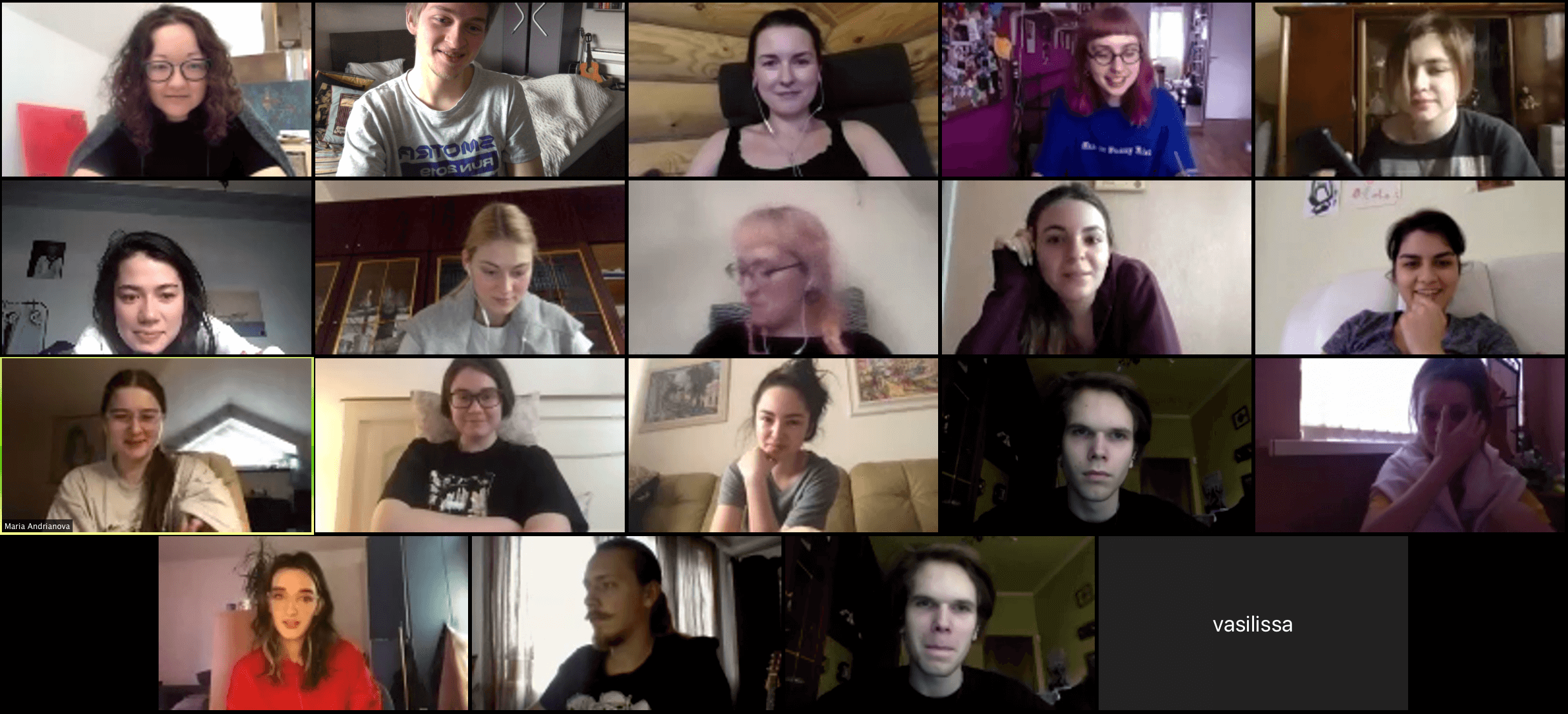
After two weeks of uncertainty, we finally arranged our first video conference with tutors via Zoom. Oh, those sweet times when it was fun, weird, and cringy at the same time!
After the discussion, we figured out the new roles which would fit for our new format, of which there were five:
• Promotion – communications with media, running course social medias and interactive strategies
• Website – designing a unified visual solution for the whole project, project showcase structure, and coding the website
• Content – collecting and editing of images and texts, keeping track of the general timeline and interim stage deadlines
• Events – a series of online live streams widening the possibilities of engagement with the individual projects and their authors
• Documentation – carefully writing and recording how it all came to be, both in video and text
After the first tutorial, the workflow slowly started to take shape.
Let us give a word to the groups themselves, describing their process and feelings.
Promotion group
Tasha, Regina, Anastasia, Valeria and Ksenia
Generally speaking, the format of the work of the Promotion group didn’t change dramatically as we all went on quarantine. All problem-solving was supposed to be in digital format as we are working with social media and the communication sphere. We can say that the quarantine made the communication even easier as we could have several zoom-meetings per week and discuss issues faster. The only significant change is that we had to invite people to an online space. We are not sure how it will influence the final result but it is obviously a different field of working rather than inviting people to a real physical exhibition space.
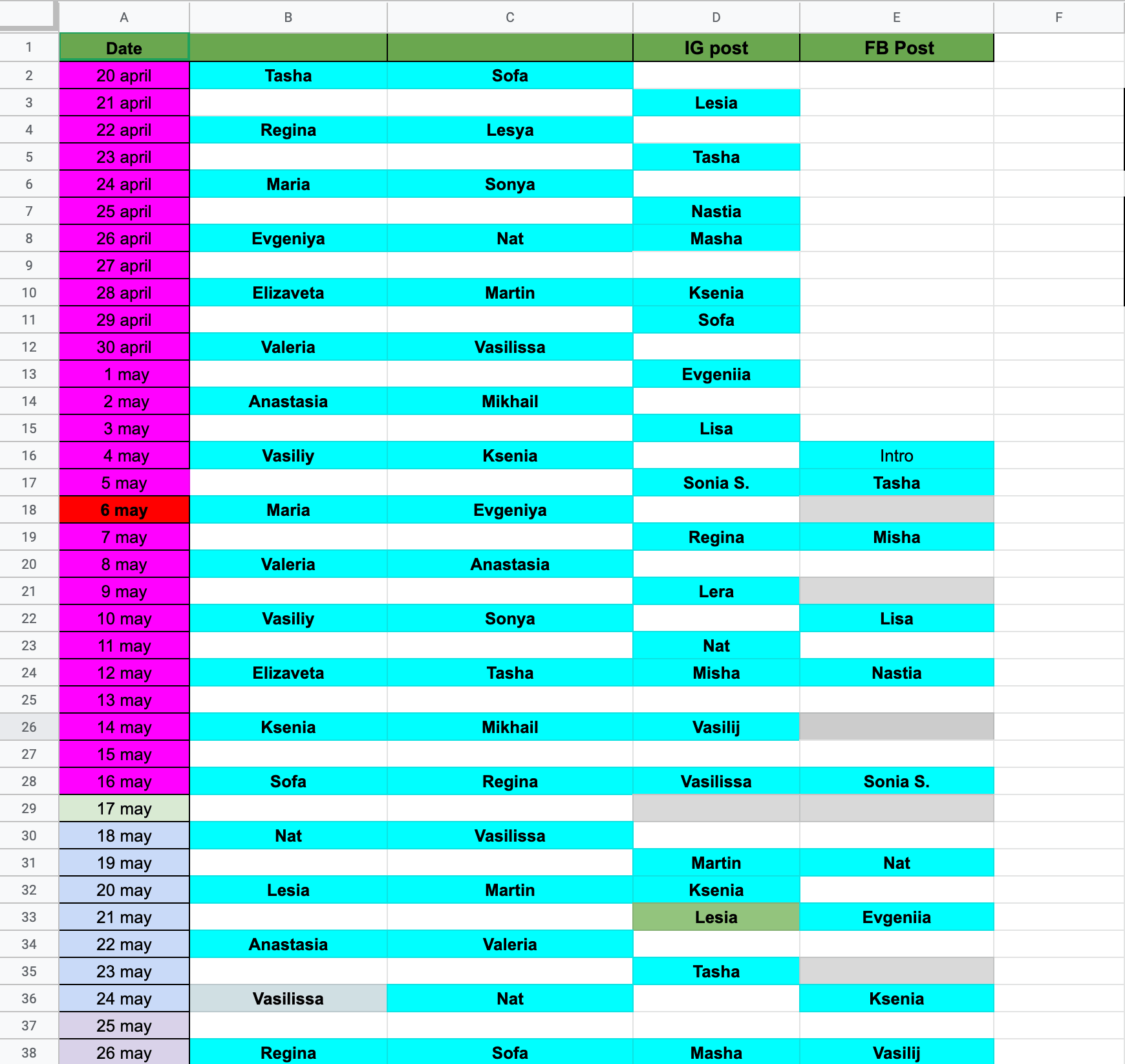
Our representative Tasha made a list of tasks from which we all chose what to do. We took responsibility for some of the tasks – like doing a content plan or making mock-ups for each work in pairs, as it was easier to manage them this way. We also had group-wide meetings once or twice a week. Communication was not always easy, we had arguments and extensive discussions but in the end, everyone had their tasks under control. There were doubts about the press-release as we started to write it ourselves but later on we decided to seek professional help so everything would be of the highest quality.
We managed to do the majority of what we’ve planned: we designed the social media promotions, invitations and press-releases and made contact lists while maintaining active Instagram and Facebook pages. The hardest part was striking a balance between appealing, eye catching visuals while cultivating an overall minimalist look of our shared instagram page.

Overall, it was a worthy experience of working as a team. No one from our group had any background in social media marketing, so obviously we struggled with decision-making sometimes. We also were the first ones from our GD group to review the deadlines and outcomes. It felt like this experience was as close as it could get to working for a client, needless to say, we learned to take responsibility for what we produce.
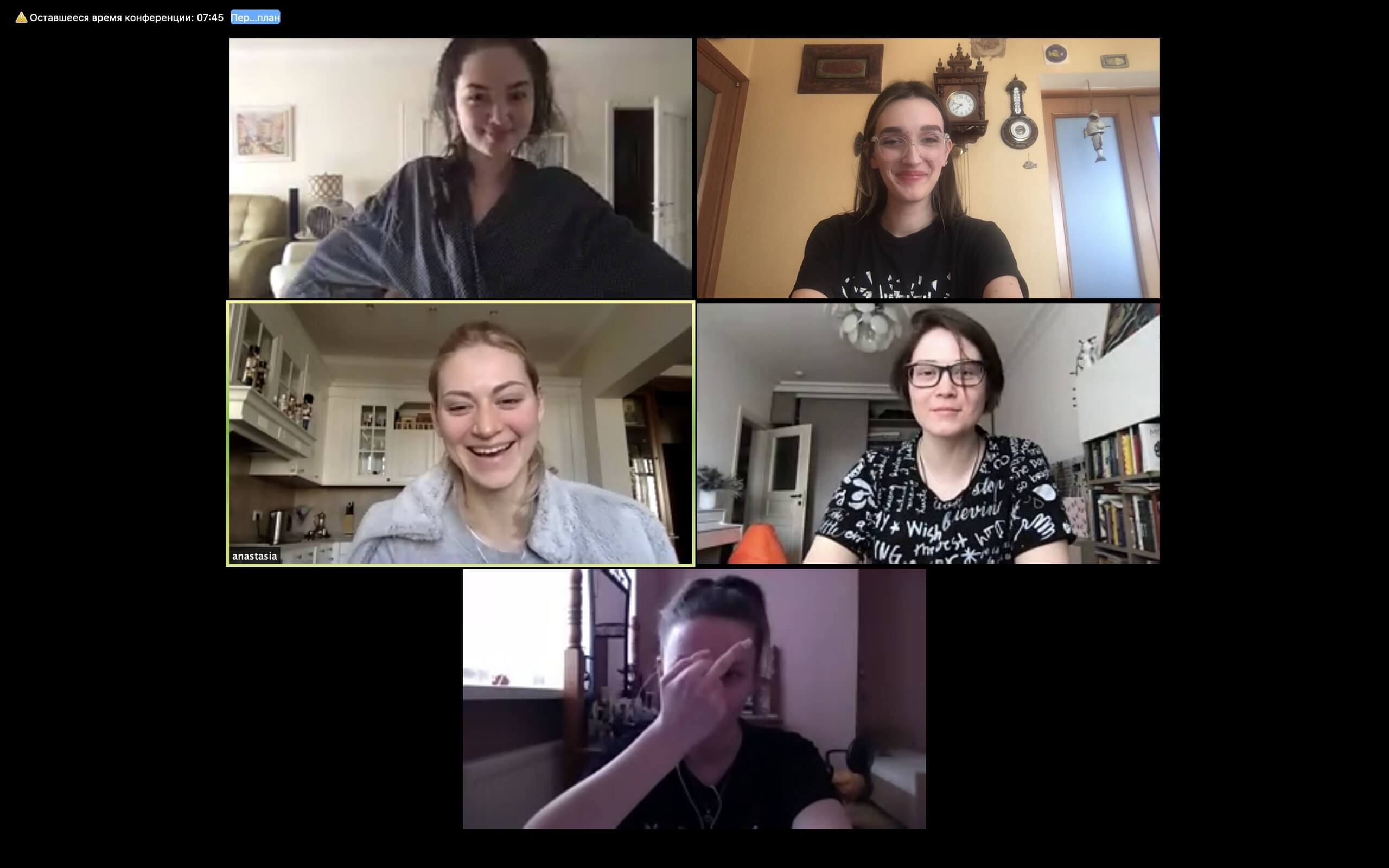
Website group
Nat, Vasya, Sonia and Liza
Our group, probably, was affected the most by the quarantine: some of us were meant to be working on the physical display of the exhibition and some were supposed to make a website but with a very different function. The biggest challenge for us was probably to somehow bring the experience of the website closer to the experience of the actual exhibition. As well as to keep everyone’s opinions in mind, and since the website is the ‘storefront’ of our exhibition, we wanted for everyone to be happy with both how it looked and functioned.
We began working individually to generate as many versions of what the website might look like as possible. And then through many discussions we slowly worked towards one collective prototype.
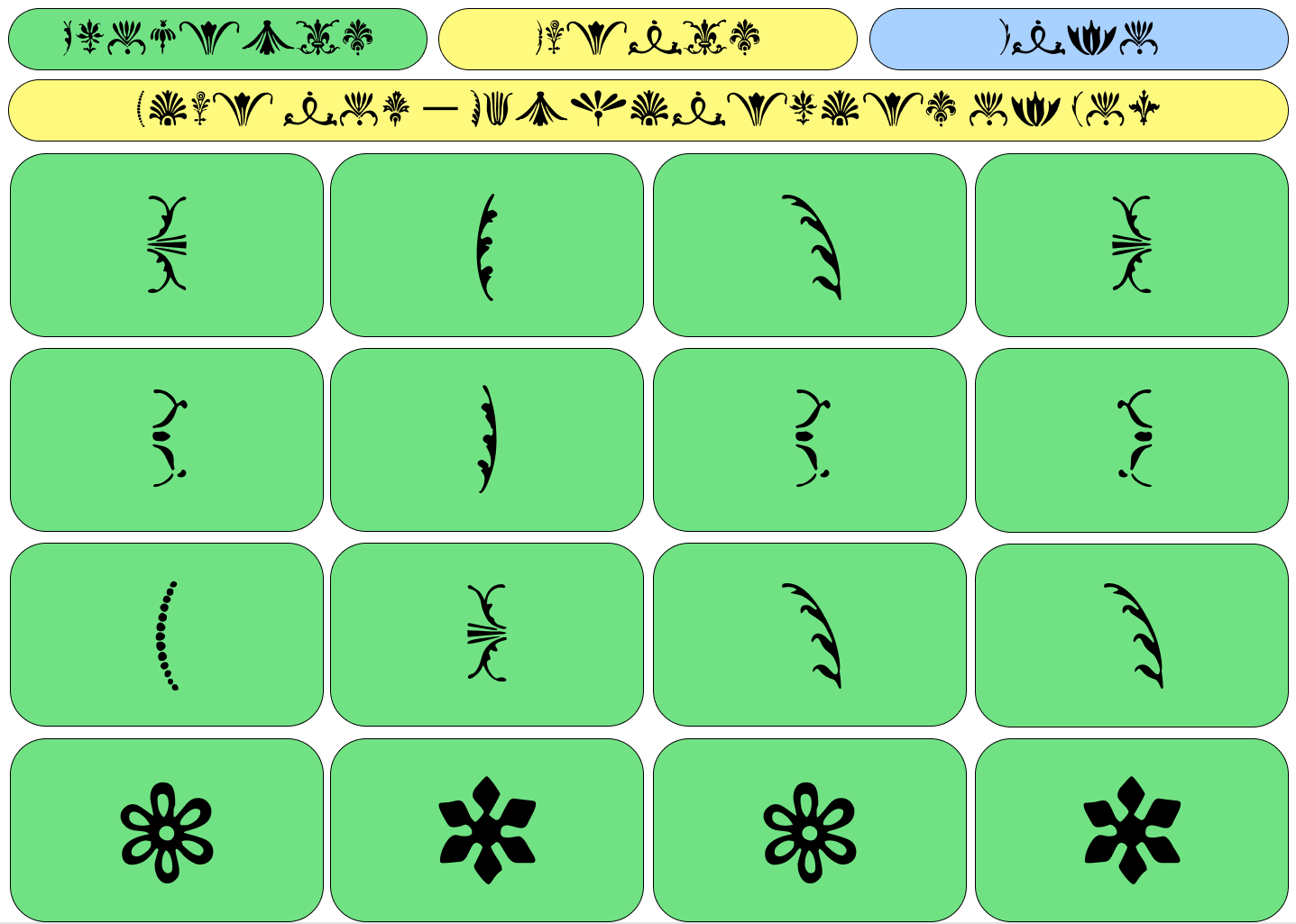
Out of all the groups, our task was probably the clearest and the most unequivocal. So fortunately we didn’t have to work out what it was that we had to make apart from actually making it, as some other groups had to. We tried our best to balance between a design that would be efficient and clear, yet not bland and boring, as this exhibition is our last project in the school ‘sandbox’ where we have almost no limitations. But we also had to always consider how complex it would be to produce the thing we designed since we’re designers and not experienced coders. We had some ideas on how to spice up the exhibition website and make it a little bit more *alive* like an online bar or something like that, but we realised pretty early into the project that we won’t have time for that.
We worked pretty well as a team and everything went smoothly. Maybe the communication could’ve been better within the group and with the rest of our class but that’s probably an unattainable ideal.

Content group
Sofa and Zhenya
The goal of the group was to collect and structure information, images, and texts that would be used on social networks and in the development of the website. We intuitively determined that the content group is the connecting link between all the participants of the process, so the main task was to convey and collect the necessary information clearly and precisely. Therefore, there would have to be a system in place for everything.
In order for each student to have access to the files, we created a Google Drive, in which each student had a space for personal content. Together we worked to ensure that each participant of the exhibition knew where to put text notes, in what format and quantity to provide photos, and how to find individual files. For these purposes, we designed a text prompt from which any student could easily get the essential information about the requirements for publishing on social media. We love the ease of use!
In addition, we notified the students about the time for posts and stories on social media once a week. But realizing that people may forget to check their dates, or will be busy with other things, we made sure to post short reminders for convenience. We realized that if we work on a schedule, remind other people about publications on time, respond to all messages, then other students will deliver content on time. The motto of the content group was if you appreciated the work of others, then they would appreciate yours too.
Basically, we coordinated and distributed responsibilities in half. They were written off every day in order to discuss the action plan and make a list of data archiving. Our decisions were always made collectively, and if any difficulties occurred, we asked for help from others.
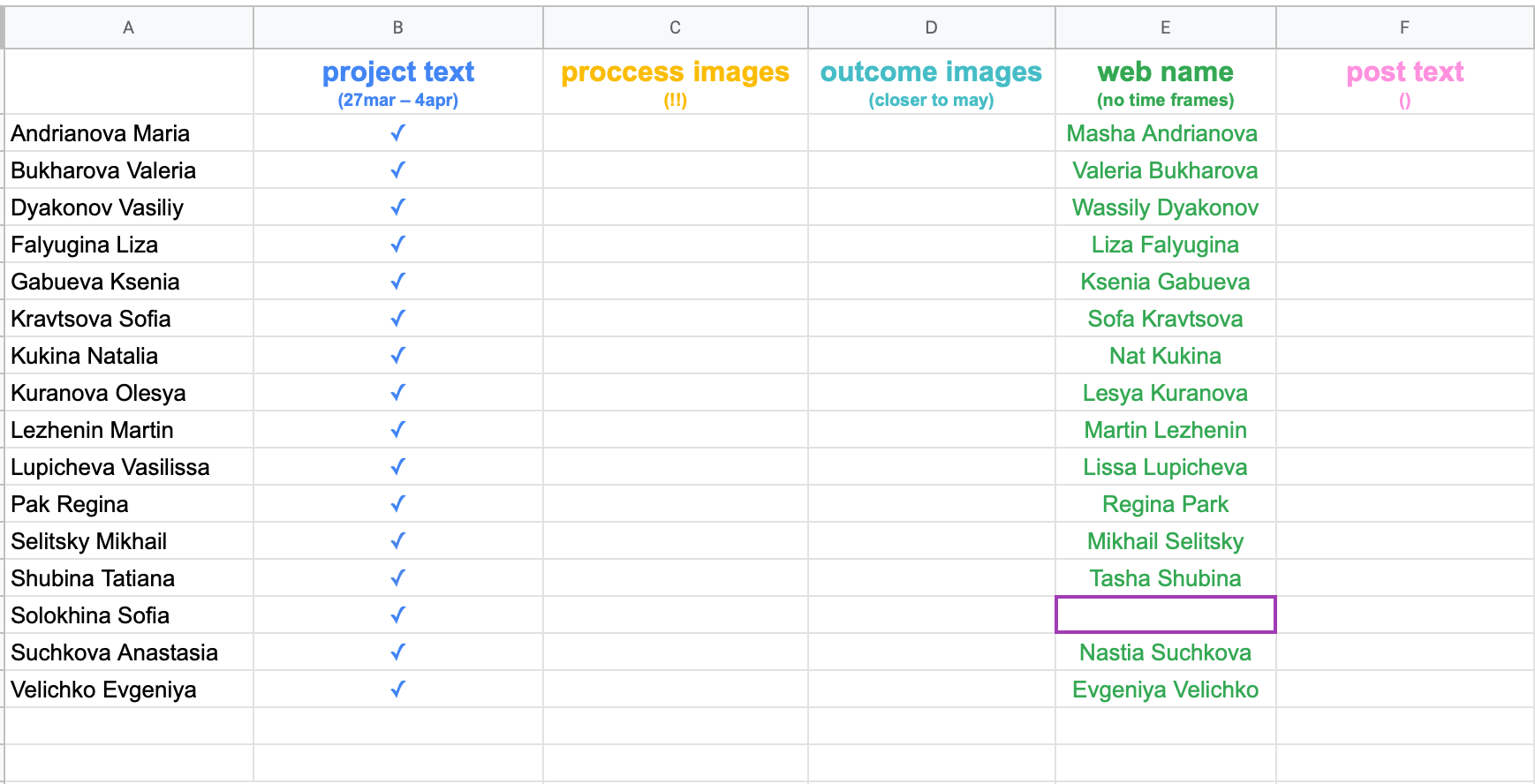
In our little duo, mutual understanding came above all else. Nobody mistreated anyone, we both took a responsible approach to work: we discussed, corrected, helped, assured each other. Sofa talked a lot with other groups and passed on to Zhenya all the important information.
There were dark moments when the group did not have the time to work with all tasks concurrently. Management in a group is a complex and engaged process. It cannot be ignored that due to a large number of tasks we had some misunderstandings – not between each other, but between other groups, but all problems were resolved very quickly and without any conflicts.
In general, we are happy with the work done. We tried to make work in the group fun, positive and enjoyable, not forgetting our responsibilities.
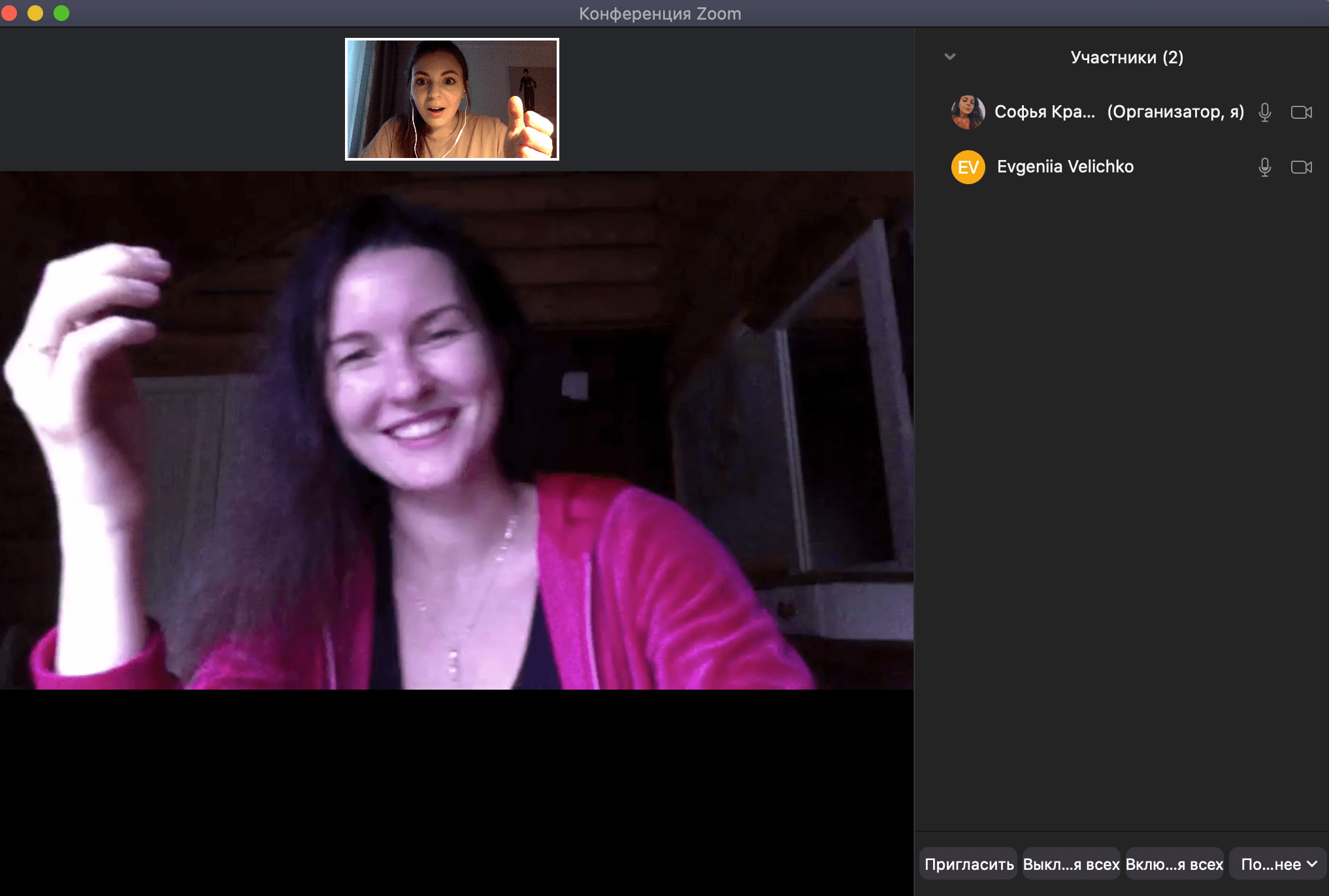

Event group
Masha and Lesya
From the very beginning of planning our show we wanted for it to be not just a static display of the works but something more engaging, something that would make people want to come see the exhibition not just at the opening day (mainly to drink free wine). Our answer to that was a series of events hosted by students that would be somehow connected to their projects and design practice.
Because of the quarantine, the events’ format has completely changed of course with all of them having to be held online. Luckily, before the quarantine we did not go as far as actually planning the events, therefore we didn’t have to throw away any work that has already been done. Everything just had to be designed from scratch.

Overall the communication between us two was not a problem at all. However, there were some problems we faced while communicating with others about their events. We really wanted these events to help people with their projects, not to become a burden for them. For some, we assume, this process did help, but others still dealt with difficulties in their time management, communication and overall desire to hold their events.
We divided all participants into two groups, so each of us ended working with 7 people. We contacted them individually and once or twice a week we would have a zoom call where we would discuss others’ progress together.

We also had a timetable where we had our assumptions on how long each event would take to produce (that includes scripting, testing, filming and post-production). For example Liza’s event, video interview, was easier to plan than Nastya’s event, video-commentary on a TikTok challenge, involving contributions from other people.
There was always the fear of people not ‘coming’ to the event, which affected the planning and production.
We really tried to make the whole experience diverse for the audience, so events would be distinct from each other. The sequence of running them was another thing to keep in mind.
At first, we really wanted the events to be experimental/meta/performative but it turned out that not everyone was on board with that.
We both enjoyed the whole experience and it was quite unique to get to know every project (AND EVERY STUDENT) in such detail. It feels like we have bonded a lot with those we didn’t expect to become friends with.
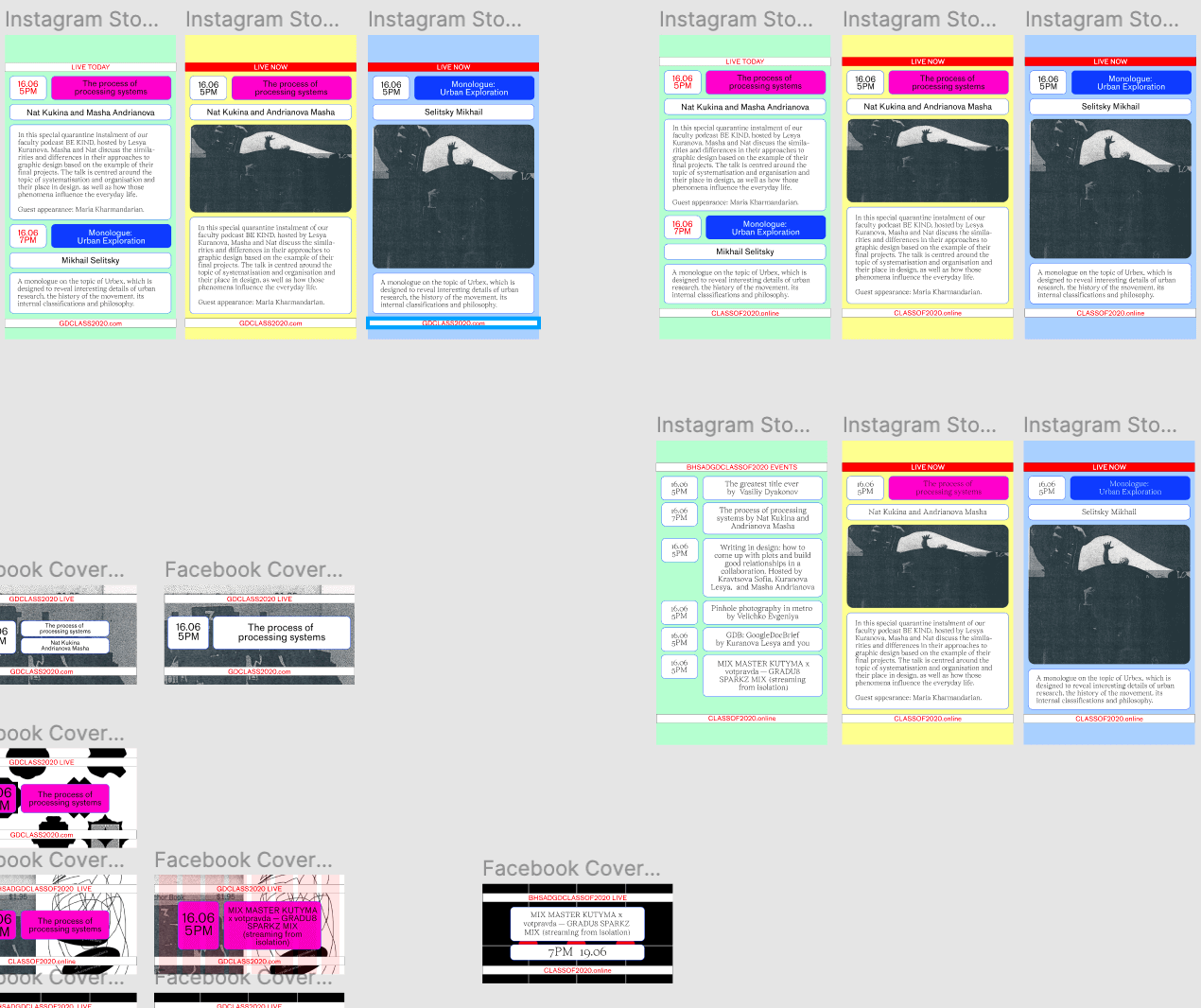
Documentation group
Martin, Vasilissa and Misha
The general concept we created at the very beginning of our work, even before the pandemic was to create a warm and cozy vibe of the graduation class. We wanted our exhibition and its documentation to feel personal, with us being on the same level with our work, telling more about ourselves rather than the projects we produce.
And even though we never considered ourselves as an actual ‘class’, we really wanted to preserve something for our future selves – as a point of reference and just for pure memory and fun.
When we did not know about the school close-down yet, we wanted to create a physical catalogue of the exhibition aimed at ourselves, serving more as a yearbook, with all the contact info, funny quotes and future expectations.
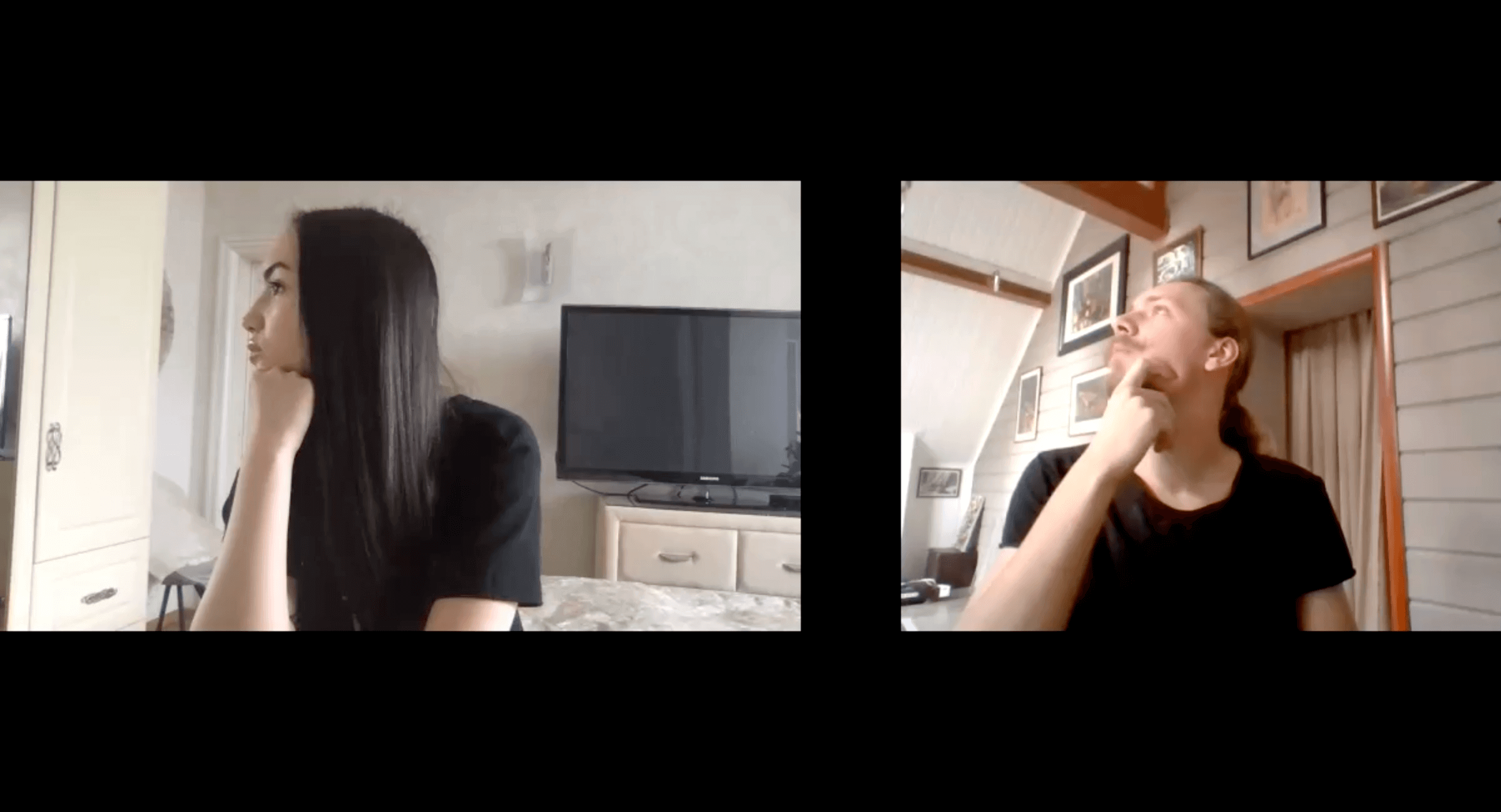
After we figured that the whole show had to go online, we understood that we needed a different medium and goal – as the works would obviously be documented well enough in the form of the website pages. Martin, as a part of the team, proposed creating a series of interviews with all of the students in order to create some kind of a memory capsule. Capturing us and our young minds talking about design, education, and life in general felt quite an intriguing project to do.
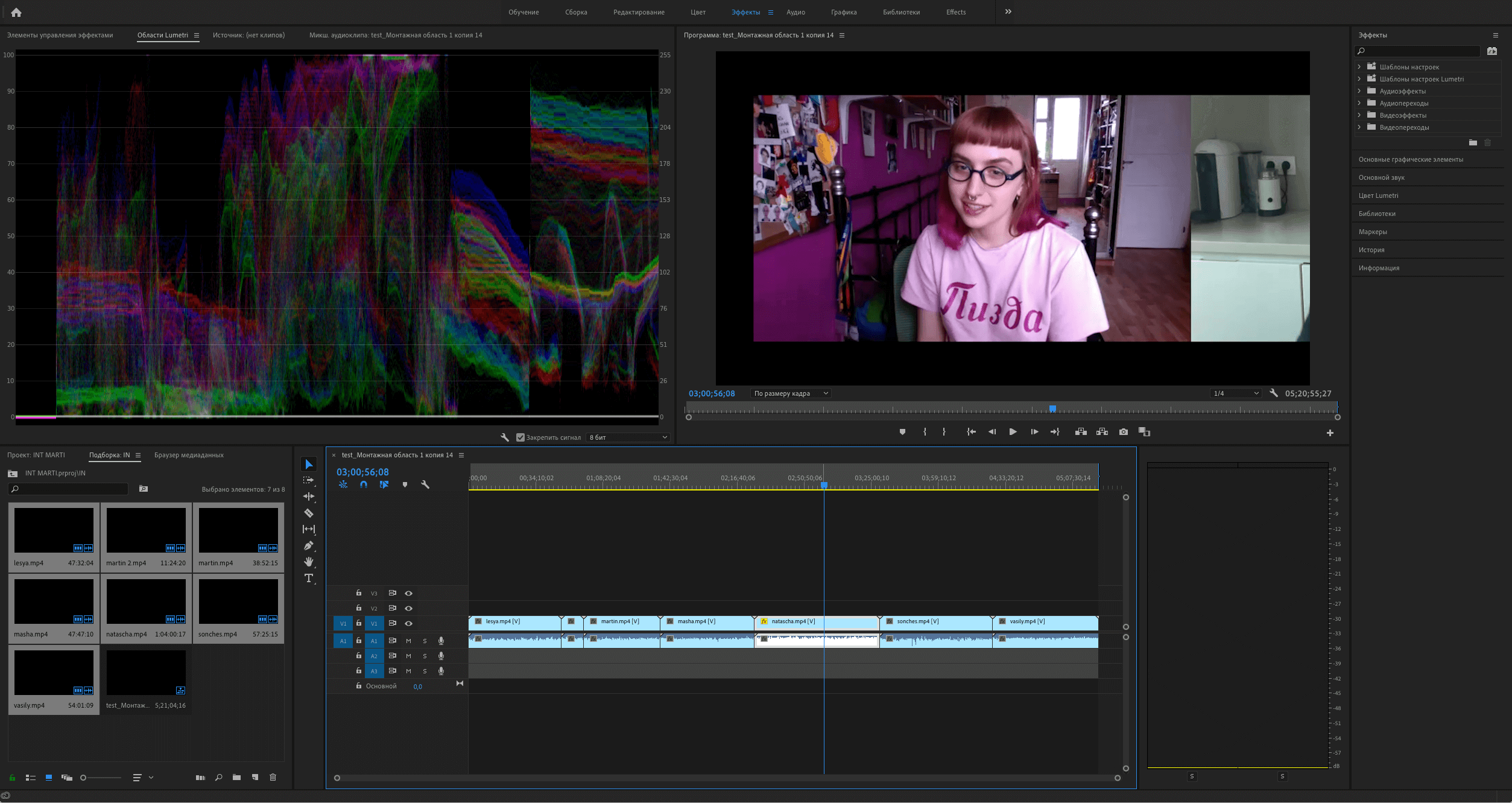
The second grand goal we set for ourselves was to meticulously record all of the changes of the whole project regarding the current situation of pandemic – this probably will be the very first fully-online graduation show. Certainly a case worth capturing and sharing!
That is why we decided that apart from the interviews, we would write an article with all the sincere thoughts and feelings about how it all came to be – what were the new tasks, how did we manage to direct the whole project into a completely different medium, what were the difficulties and what creative solutions did we manage to invent under these circumstances, keeping in mind that the whole process went completely online, with no meetings and discussions in person.
This all seemed as a good cause for a descriptive article which could be posted at various design media like It’s Nice That (oh, those sweet dreams) (UPD_20200831: look, we actually
The overall process of us working as a group went beyond any expectations. Given the fact that we were neither friends nor have worked in group projects together before, the whole workflow went really smooth and bonded us greater in two months than in all four years of the concluding education. Not only are we pleased by the outcomes we produced, but we also managed to achieve a high level of communication understanding, responsibilities managing, and – cannot believe we are writing this – time management! Even though we created a very rough schedule for ourselves, we managed to deliver all of the desired outcomes even before that, finalising the submission way before the deadline. Overall, it has been a pleasure to work all together for the very last time creating some warm memories to cherish forever.
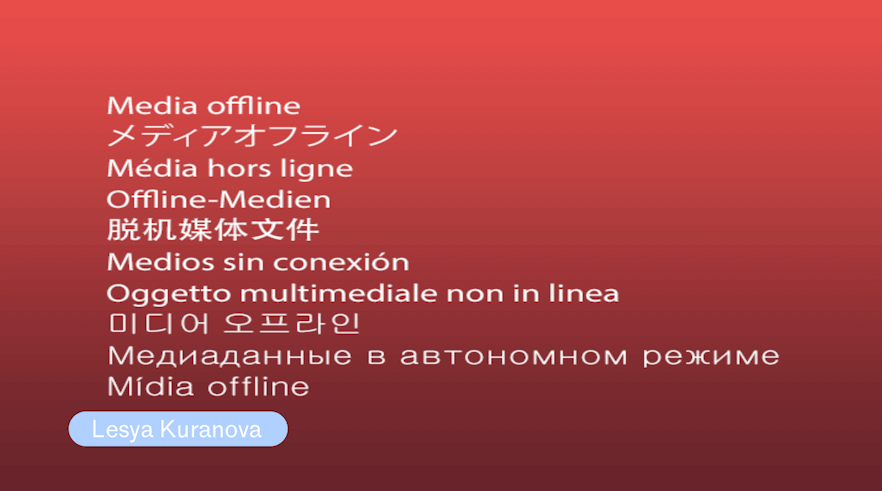
To sum things up
Through hours of zoom calls and thousands of messages, we surprisingly managed to finish the whole project with no big drama or quarrel. Moreover, even though we had collaborative assignments as a whole group before, all of the participants explicitly noted that this project felt quite like a team building endeavour which finally felt right. It allowed us to rediscover each other in a much more intimate way before our paths will go in different directions and our connections are very likely to dissolve. This is a definitive proof that we all can actually manage the workflow between each other, providing help and assistance within the groups, efficiently communicating and making solid decisions all together, for the first time as one class – GD class of 2020.
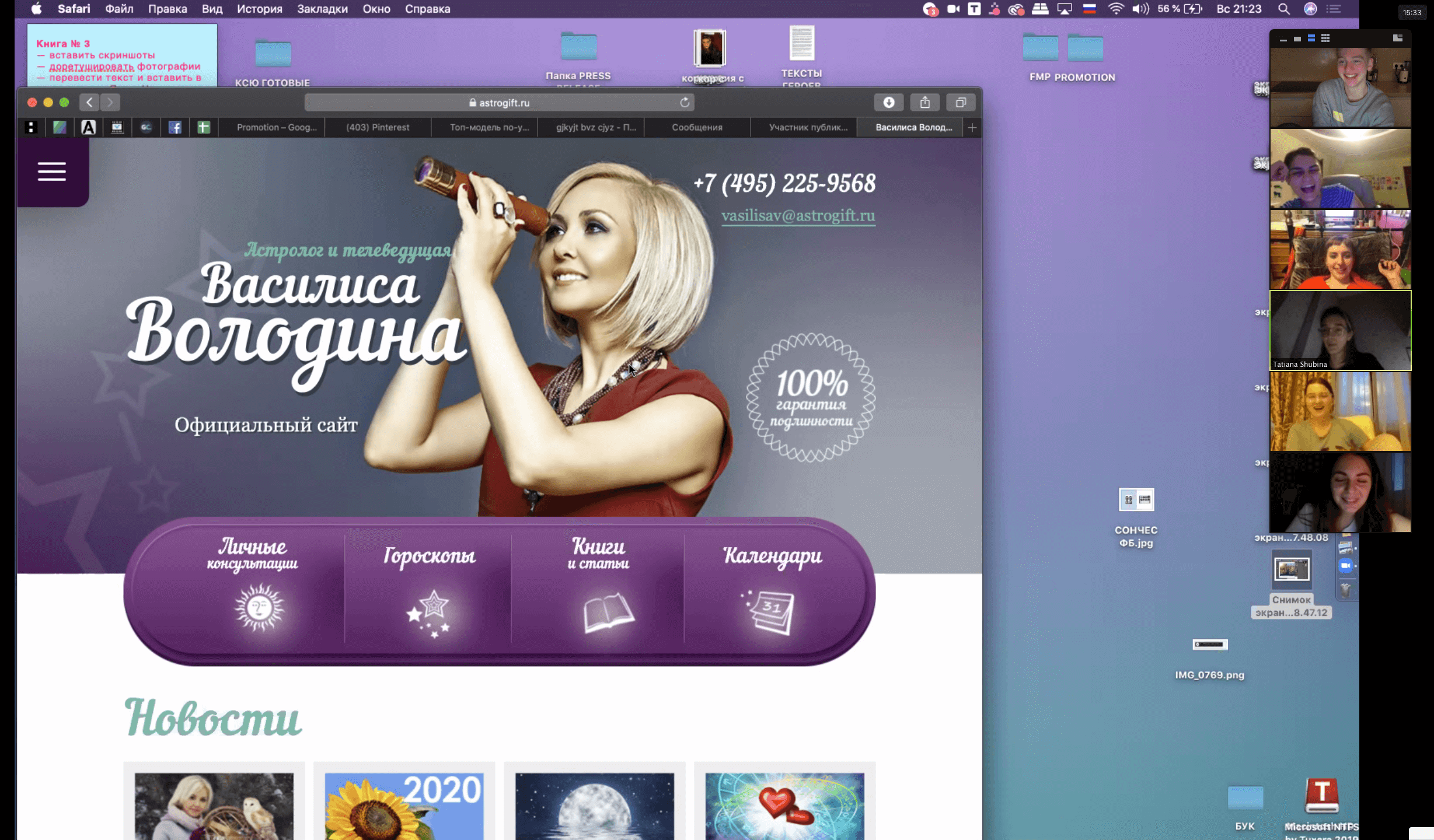
It all started very optimistically.
On the 11th of March, we, the graduating students of Graphic Design, faculty of the British Higher School of Art and Design, first gathered all together in our studio to collectively decide upon our Final Degree Show. By that time, there were only 8 cases of Covid-19 confirmed in Russia, and no-one really could predict what would happen next, and how our plans to collect and showcase our degree projects as a group of undergraduate students for the very last time would shatter to pieces within the following couple weeks.
The fate of the Degree Show remained uncertain. It was either to be postponed – until the following summer months, or next year graduation – or cancelled all together. Deciding not to wait until the official conclusion of the administration, we collectively agreed to take the whole thing online. After a hard two months, we finally proudly present to you the website you are currently on.

Making this work was not easy. The final displays were a part of our module from the very beginning, yet our original split into the three groups – before (promotion, communication), during (display, information), and after (documentation, dissemination) – was no longer definitive enough and required restructuring. With no walls, captions, and plinths, we were about to discover a new path – probably the first fully online diploma show ever, not by the concept, but by the global cause.
Even though making a website was no big deal for us – we made them last year within our own study project, there were lots of different questions to consider and solve – how do we make most of each project even though the formats and mediums are of all sorts and kinds? How do we attract a professional audience and make sure they can thoroughly examine all of the works? How do we make it appealing and lively for both us and the wider audience?

After the first tutorial, the workflow slowly started to take shape.
Let us give a word to the groups themselves, describing their process and feelings.
Promotion group
Tasha, Regina, Anastasia, Valeria and Ksenia
Generally speaking, the format of the work of the Promotion group didn’t change dramatically as we all went on quarantine. All problem-solving was supposed to be in digital format as we are working with social media and the communication sphere. We can say that the quarantine made the communication even easier as we could have several zoom-meetings per week and discuss issues faster. The only significant change is that we had to invite people to an online space. We are not sure how it will influence the final result but it is obviously a different field of working rather than inviting people to a real physical exhibition space.

Website group
Nat, Vasya, Sonia and Liza
Our group, probably, was affected the most by the quarantine: some of us were meant to be working on the physical display of the exhibition and some were supposed to make a website but with a very different function. The biggest challenge for us was probably to somehow bring the experience of the website closer to the experience of the actual exhibition. As well as to keep everyone’s opinions in mind, and since the website is the ‘storefront’ of our exhibition, we wanted for everyone to be happy with both how it looked and functioned.
We began working individually to generate as many versions of what the website might look like as possible. And then through many discussions we slowly worked towards one collective prototype.
Out of all the groups, our task was probably the clearest and the most unequivocal. So fortunately we didn’t have to work out what it was that we had to make apart from actually making it, as some other groups had to. We tried our best to balance between a design that would be efficient and clear, yet not bland and boring, as this exhibition is our last project in the school ‘sandbox’ where we have almost no limitations. But we also had to always consider how complex it would be to produce the thing we designed since we’re designers and not experienced coders. We had some ideas on how to spice up the exhibition website and make it a little bit more *alive* like an online bar or something like that, but we realised pretty early into the project that we won’t have time for that.
In addition, we notified the students about the time for posts and stories on social media once a week. But realizing that people may forget to check their dates, or will be busy with other things, we made sure to post short reminders for convenience. We realized that if we work on a schedule, remind other people about publications on time, respond to all messages, then other students will deliver content on time. The motto of the content group was if you appreciated the work of others, then they would appreciate yours too.
Basically, we coordinated and distributed responsibilities in half. They were written off every day in order to discuss the action plan and make a list of data archiving. Our decisions were always made collectively, and if any difficulties occurred, we asked for help from others.

In our little duo, mutual understanding came above all else. Nobody mistreated anyone, we both took a responsible approach to work: we discussed, corrected, helped, assured each other. Sofa talked a lot with other groups and passed on to Zhenya all the important information.
There were dark moments when the group did not have the time to work with all tasks concurrently. Management in a group is a complex and engaged process. It cannot be ignored that due to a large number of tasks we had some misunderstandings – not between each other, but between other groups, but all problems were resolved very quickly and without any conflicts.
In general, we are happy with the work done. We tried to make work in the group fun, positive and enjoyable, not forgetting our responsibilities.

Overall the communication between us two was not a problem at all. However, there were some problems we faced while communicating with others about their events. We really wanted these events to help people with their projects, not to become a burden for them. For some, we assume, this process did help, but others still dealt with difficulties in their time management, communication and overall desire to hold their events.
We divided all participants into two groups, so each of us ended working with 7 people. We contacted them individually and once or twice a week we would have a zoom call where we would discuss others’ progress together.

We also had a timetable where we had our assumptions on how long each event would take to produce (that includes scripting, testing, filming and post-production). For example Liza’s event, video interview, was easier to plan than Nastya’s event, video-commentary on a TikTok challenge, involving contributions from other people.
There was always the fear of people not ‘coming’ to the event, which affected the planning and production.
We really tried to make the whole experience diverse for the audience, so events would be distinct from each other. The sequence of running them was another thing to keep in mind.
At first, we really wanted the events to be experimental/meta/performative but it turned out that not everyone was on board with that.
After we figured that the whole show had to go online, we understood that we needed a different medium and goal – as the works would obviously be documented well enough in the form of the website pages. Martin, as a part of the team, proposed creating a series of interviews with all of the students in order to create some kind of a memory capsule. Capturing us and our young minds talking about design, education, and life in general felt quite an intriguing project to do.

The second grand goal we set for ourselves was to meticulously record all of the changes of the whole project regarding the current situation of pandemic – this probably will be the very first fully-online graduation show. Certainly a case worth capturing and sharing!
That is why we decided that apart from the interviews, we would write an article with all the sincere thoughts and feelings about how it all came to be – what were the new tasks, how did we manage to direct the whole project into a completely different medium, what were the difficulties and what creative solutions did we manage to invent under these circumstances, keeping in mind that the whole process went completely online, with no meetings and discussions in person.
This all seemed as a good cause for a descriptive article which could be posted at various design media like It’s Nice That (oh, those sweet dreams) (UPD_20200831: look, we actually made it), but at least we would save it to retell to our kids!
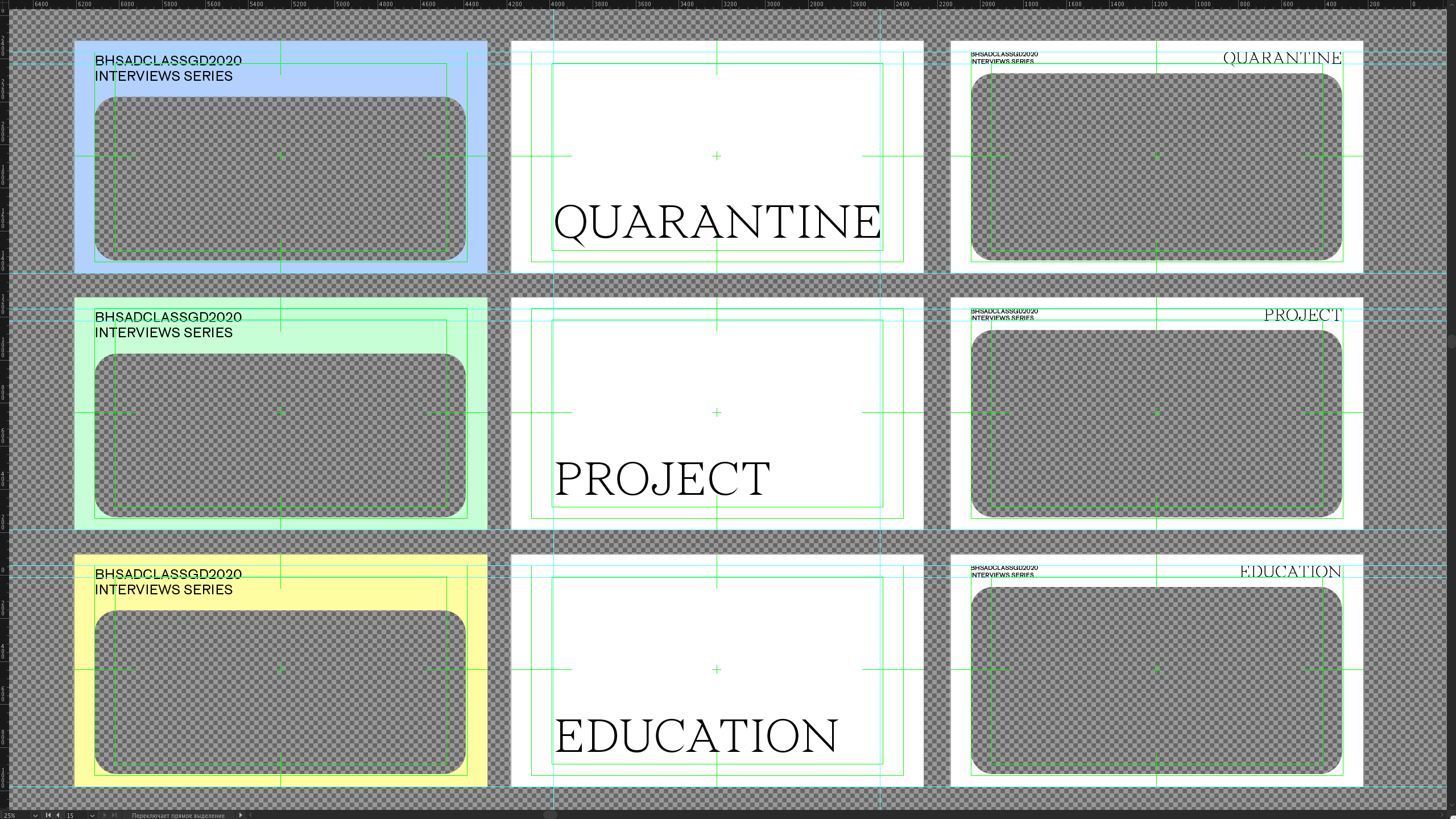
Five days later, a letter came from the Head of British Programmes, stating that the University will be closed for two weeks. It was quite a late, yet expectable move. However, it would be matter of days until we understood we would not be able to access our campus till the very end of the semester.

While preparing for the online exhibition, we also conducted a series of interviews with ourselves, marking this uneasy period of our lives and making sure that we have our minds and thoughts carefully recorded for the future reference. The following is a series of 6 short films with the most important and recent topics which bother us the most before we graduate.
After two weeks of uncertainty, we finally arranged our first video conference with tutors via Zoom. Oh, those sweet times when it was fun, weird, and cringy at the same time!
After the discussion, we figured out the new roles which would fit for our new format, of which there were five:
• Promotion – communications with media, running course social medias and interactive strategies
• Website – designing a unified visual solution for the whole project, project showcase structure, and coding the website
• Content – collecting and editing of images and texts, keeping track of the general timeline and interim stage deadlines
• Events – a series of online live streams widening the possibilities of engagement with the individual projects and their authors
• Documentation – carefully writing and recording how it all came to be, both in video and text

Our representative Tasha made a list of tasks from which we all chose what to do. We took responsibility for some of the tasks – like doing a content plan or making mock-ups for each work in pairs, as it was easier to manage them this way. We also had group-wide meetings once or twice a week. Communication was not always easy, we had arguments and extensive discussions but in the end, everyone had their tasks under control. There were doubts about the press-release as we started to write it ourselves but later on we decided to seek professional help so everything would be of the highest quality.
We managed to do the majority of what we’ve planned: we designed the social media promotions, invitations and press-releases and made contact lists while maintaining active Instagram and Facebook pages. The hardest part was striking a balance between appealing, eye catching visuals while cultivating an overall minimalist look of our shared instagram page.

Overall, it was a worthy experience of working as a team. No one from our group had any background in social media marketing, so obviously we struggled with decision-making sometimes. We also were the first ones from our GD group to review the deadlines and outcomes. It felt like this experience was as close as it could get to working for a client, needless to say, we learned to take responsibility for what we produce.


We worked pretty well as a team and everything went smoothly. Maybe the communication could’ve been better within the group and with the rest of our class but that’s probably an unattainable ideal.

Content group
Sofa and Zhenya
The goal of the group was to collect and structure information, images, and texts that would be used on social networks and in the development of the website. We intuitively determined that the content group is the connecting link between all the participants of the process, so the main task was to convey and collect the necessary information clearly and precisely. Therefore, there would have to be a system in place for everything.
In order for each student to have access to the files, we created a Google Drive, in which each student had a space for personal content. Together we worked to ensure that each participant of the exhibition knew where to put text notes, in what format and quantity to provide photos, and how to find individual files. For these purposes, we designed a text prompt from which any student could easily get the essential information about the requirements for publishing on social media. We love the ease of use!

Event group
Masha and Lesya
From the very beginning of planning our show we wanted for it to be not just a static display of the works but something more engaging, something that would make people want to come see the exhibition not just at the opening day (mainly to drink free wine). Our answer to that was a series of events hosted by students that would be somehow connected to their projects and design practice.
Because of the quarantine, the events’ format has completely changed of course with all of them having to be held online. Luckily, before the quarantine we did not go as far as actually planning the events, therefore we didn’t have to throw away any work that has already been done. Everything just had to be designed from scratch.

We both enjoyed the whole experience and it was quite unique to get to know every project (AND EVERY STUDENT) in such detail. It feels like we have bonded a lot with those we didn’t expect to become friends with.

Documentation group
Martin, Vasilissa and Misha
The general concept we created at the very beginning of our work, even before the pandemic was to create a warm and cozy vibe of the graduation class. We wanted our exhibition and its documentation to feel personal, with us being on the same level with our work, telling more about ourselves rather than the projects we produce.
And even though we never considered ourselves as an actual ‘class’, we really wanted to preserve something for our future selves – as a point of reference and just for pure memory and fun.
When we did not know about the school close-down yet, we wanted to create a physical catalogue of the exhibition aimed at ourselves, serving more as a yearbook, with all the contact info, funny quotes and future expectations.

The overall process of us working as a group went beyond any expectations. Given the fact that we were neither friends nor have worked in group projects together before, the whole workflow went really smooth and bonded us greater in two months than in all four years of the concluding education. Not only are we pleased by the outcomes we produced, but we also managed to achieve a high level of communication understanding, responsibilities managing, and – cannot believe we are writing this – time management! Even though we created a very rough schedule for ourselves, we managed to deliver all of the desired outcomes even before that, finalising the submission way before the deadline. Overall, it has been a pleasure to work all together for the very last time creating some warm memories to cherish forever.

To sum things up
Through hours of zoom calls and thousands of messages, we surprisingly managed to finish the whole project with no big drama or quarrel. Moreover, even though we had collaborative assignments as a whole group before, all of the participants explicitly noted that this project felt quite like a team building endeavour which finally felt right. It allowed us to rediscover each other in a much more intimate way before our paths will go in different directions and our connections are very likely to dissolve. This is a definitive proof that we all can actually manage the workflow between each other, providing help and assistance within the groups, efficiently communicating and making solid decisions all together, for the first time as one class – GD class of 2020.
